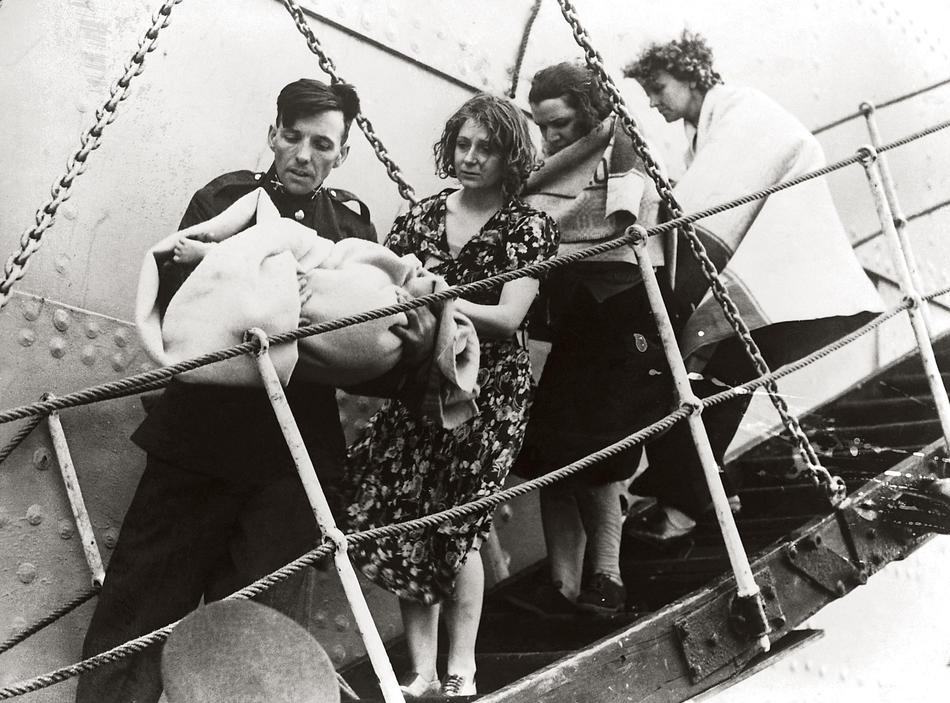The idea that the United States stayed on the sidelines of World War II until the Japanese attacked the Pacific fleet at Pearl Harbor is accurate — but not completely. Within hours of Britain’s declaration of war against Germany on September 3, 1939, the commander of a U-boat, interpreting liberally his orders of engagement, torpedoed and sank the British passenger steamer SS Athenia northwest of Ireland. She was the first casualty of the Battle of the Atlantic; among her 1102 passengers were 300 Americans. All but 118 survived.
For the next six years, over an area of tens of millions of square miles, the Atlantic Ocean was a battlefield, though with action very unlike the epic naval battles fought in the Pacific, where destroyers and carriers hammered one another, and waves of fighter planes attacked from over the horizon. Rather, until 1943, the Atlantic was controlled nearly at will by German U-boats attacking North American merchant ships sailing along the East Coast of the United States and then from U.S. ports to England and the Soviet Union. Richard Snow ’70CC tells the largely neglected story in A Measureless Peril: America in the Fight for the Atlantic, the Longest Battle of World War II. The title alludes not to the vastness of the ocean, but to Churchill’s perception of the gravity of the U-boat’s strangulation of the British Isles. Without matérial, fuel, food, and equipment from America, England would not be able to hold on against Germany.
By the end of the war, 3500 merchant ships carrying 14.5 million tons of cargo had been lost. “The battle,” writes Snow, “killed nearly 80,000 people: drowned them, crushed them, burned them, froze them, starved them in lifeboats.”
In the early years of the war, U-boats picked off merchant ships with the casual ease of a farm boy shooting bottles off a fence. Freighters were slow, easy to spot, and poorly defended. German sailors called this the glückliche Zeit — the Happy Time.
In December 1941, Admiral Karl Dönitz, the head of the German submarine fleet, sent the five U-boats he had available toward the U.S. on Operation Paukenschlag. U-123, pausing to destroy the Panama-to-Halifax-bound British merchantman Cyclops, passed the Montauk Point light on January 14, 1942. “Running on the surface,” writes Snow, the U-boat captain Reinhard Hardegan and his crew “saw automobile headlights pass and bright geometries of streetlights behind them...Didn’t the creators of this smug efflorescence know they were at war?”
The U-boat made its way into New York Harbor; the crew gaped at the skyline and later saw the Ferris wheel at Coney Island. After their sightseeing, Hardegan came across a British tanker “fat with 80 thousand barrels of oil. He fired two torpedoes and split it in three pieces. The captain and 35 of the crew burned to death.” Seeing the blaze, residents of Long Island reacted the only way they could, by calling the police.
U-boats attacked along the coast again and again, as ships stood out against the brightly lit shore towns. “Those city lights that amazed and fascinated Hardegan and [Peter-Erich] Cremer on their first American voyages just kept burning. In the disorderly process of a democracy going to war, it turned out that nobody had the authority to make the mayor of Atlantic City darken his town. Admiral Andrews begged municipalities to institute blackouts and was told, in effect, fat chance. The town fathers of Miami indignantly stated that it would discourage tourists and be bad for business. Why a darkened marquee on the Frolic Club or the Chez Paree would dispirit vacationers more than morning strolls past oil-sodden corpses on beaches was never explained.”
Snow’s evocation of U-boat life is strong and vivid. He describes the complexity of the vessel (and of its miniature, the torpedo) and its inhospitality to its crews: “Everything dripped, everything stank. Clothing was always damp and soon dirty.” The mechanically demanding U-boats, writes Snow, “as efficient-looking as bullets, and with the same aura of lethal inertness, were actually as restive as a cargo of live cougars, and the crew had to start tending to their incessant demands just hours after the boat sailed.”
The immediate success of the U-boat offensive was not surprising, given the discipline and professionalism of the crews and the vulnerability of their targets. It took years for the Americans in particular to figure out how to protect the slow merchant convoys against attacks from the U-boat “wolf packs.” Then, for example, it was one thing to come up with the idea for destroyer escorts; it was another to build them.
The tide turned after U.S. shipyards began launching Liberty ships faster than they could be sunk (more than 2700 of these cheap, no-frills cargo ships were built during the war), after small destroyer escorts had been designed and assigned to protect merchantmen, after the British had broken Germany’s top-secret Enigma code, and after sonar and radar came into play for the allies. (Columbia physicist I. I. Rabi ’27GSAS, working on the radar project at MIT’s Radiation Laboratory, was so “dedicated to doing all a scientist could to stop Hitler,” writes Snow, that he confronted every new idea with the question, “How many Germans will it kill?”) Those tools put U-boats on the defensive and then on the run.
World War II gives us many examples of America learning terrible lessons in battle and then bringing that experience, and the weight of U.S. industrial production, to bear on its enemies in future encounters. This was so with the Battle of the Atlantic, and Snow, who edited American Heritage magazine from 1990 until it folded three years ago, shows us how slow the country was not only to learn those lessons but even to acknowledge that it was at war. Yet even with the Allies’ reconquest of the ocean, the battle lasted into the spring of 1945, when the newest and most lethal class of U-boat set out from Kiel. On April 24, U-546 torpedoed the destroyer USS Frederick C. Davis, which was too slow on the draw. That same day, the sub was pulverized into submission by a group of the Davis’s sister ships.
This important and enjoyable book prompts two quibbles. Snow interleaves the big story of the war-long battle of the Atlantic with lively portraits of lead players, such as Admiral Dönitz, and supporting players, including Snow’s father, Lieutenant Richard B. Snow ’31GSAPP, who served aboard the destroyer USS Neunzer (and after the war designed the Barnard library). All the material is interesting, but the stories tug in different directions, so the sweep of the narrative is sometimes lost.
The other gripe is that Snow’s dramatic, you-are-there descriptions are so good that the book’s absence of endnotes makes one wonder where he learned this detail of U-boat operation or caught that essential vignette from the scene of the sinking Stephen Hopkins. Neither of these points keeps his history from being a fine overview of the Battle of the Atlantic.
Donald Keene’s So Lovely a Country Will Never Perish: Wartime Diaries of Japanese Writers is as micro as Snow’s book is macro. Keene ’42CC, ’49GSAS, ’97HON is Shincho Professor of Japanese Literature and University Professor Emeritus and served as a Navy translator during World War II. His job was to read captured Japanese documents, including the journals of soldiers and sailors. In this intriguing little book, he explores the diaries not of enlisted men, but of Japanese literary figures, several of whom he knew after the war.
Some of these writers were admirers of Western culture and were distressed, if only in the secrecy of their diaries, by the outbreak of what they knew was an unwinnable war. Others rallied around the emperor. A 21st-century American reader, with post-Hiroshima hindsight and warm feelings toward Japan, may be startled by the bellicosity of the latter. The poet Saito Ryu wrote in December 1941: “The time has come / To slaughter America and England. / Ah, how refreshing! / The clouds in the four heavens / Have simultaneously cleared.”
If anything is “refreshing” it is journal entries from the American occupation like this one by Takami Jun: “The streets of Tokyo swarm with American servicemen. . . . But no matter where I have gone, I have never seen an American soldier strike a Japanese or behave with an air of superiority or in a menacing manner.”



